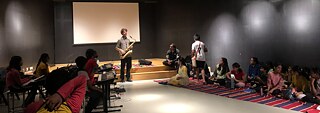Julius Gabriel
bangaloREsident@IME
Julius Gabriel (*1988 in East Berlin) is a saxophonist and works as a freelance musician. His work as a solo artist focuses mainly on the exploration of the saxophone. He is dedicated to improvisation, uses extended playing techniques and investigates the multidimensional unfolding of the sound of his instruments through spatial and electroacoustics. Since 2017, he has released the solo albums Dream Dream Beam Beam, Ætherhallen, Geminga, and Eyes in Orbits. He is currently working on new music for a tenor saxophone, prepared with multiple transducers and a soprano saxophone, extended with a double mouthpiece and drone pipe.
He has performed solo, as well as with large ensembles, as a guest musician, and with his own projects at festivals all over Europe including blurred edges, Fusion, Open Source, Moers Festival, unerhört!, Sidéral Psych Fest, Keroxen, Rainy Days, Ad Libitum, Krakow Jazz Autumn, Jazztopad, Tremor, Jazz em Agosto, Milhões de Festa, Primavera Sounds, Sonic Blast, SWR Metalfest, Waking Life, Zigurfest and on albums released on labels such as Rocket Recordings, Lovers&Lollypops, Subcontinental Records, Creative Sources, Ana Ott, Umland Records, Not Two Records and Intakt Records.
At the Folkwang University of the Arts in Essen (North Rhine-Westphalia), he played in new music ensembles, took courses in acoustics and notation, among others, and completed the BA Jazz Performing Artist in 2015. In 2016, an artist scholarship took him to Portugal, where he has worked regularly since. He currently lives between Porto and Berlin.
During the bangaloREsidency 2022 at the Indian Music Experience Museum, he plans to reconstruct an antique diatonic sopranino saxophone in cooperation with a local instrument maker, play with local percussionists, make feld as well as studio recordings, and take lessons in Carnatic saxophone.
He has performed solo, as well as with large ensembles, as a guest musician, and with his own projects at festivals all over Europe including blurred edges, Fusion, Open Source, Moers Festival, unerhört!, Sidéral Psych Fest, Keroxen, Rainy Days, Ad Libitum, Krakow Jazz Autumn, Jazztopad, Tremor, Jazz em Agosto, Milhões de Festa, Primavera Sounds, Sonic Blast, SWR Metalfest, Waking Life, Zigurfest and on albums released on labels such as Rocket Recordings, Lovers&Lollypops, Subcontinental Records, Creative Sources, Ana Ott, Umland Records, Not Two Records and Intakt Records.
At the Folkwang University of the Arts in Essen (North Rhine-Westphalia), he played in new music ensembles, took courses in acoustics and notation, among others, and completed the BA Jazz Performing Artist in 2015. In 2016, an artist scholarship took him to Portugal, where he has worked regularly since. He currently lives between Porto and Berlin.
During the bangaloREsidency 2022 at the Indian Music Experience Museum, he plans to reconstruct an antique diatonic sopranino saxophone in cooperation with a local instrument maker, play with local percussionists, make feld as well as studio recordings, and take lessons in Carnatic saxophone.





